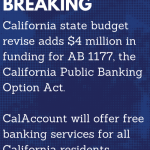NextCity – Twice a year, when property owners pay their local property tax bills, Alameda County Treasurer Hank Levy sees a huge influx of cash into county coffers. After paying off the county’s own bills and other expenses, there’s always some cash left over that doesn’t need to be spent right away — though it’s all earmarked for salaries, programs, projects and other costs that come up later. As do most local or state treasurers, Levy’s office invests whatever he doesn’t need to spend right away, earning some interest for the county in the meantime.
Right now, Levy’s office holds an investment portfolio of around $7 billion. About half of that is invested in U.S. Treasury Bonds or other securities backed by the Federal Government — assets that don’t earn very much interest right now but they are considered “highly liquid,” meaning Levy can sell them easily to other investors when the county needs the cash. Another 20% of the portfolio is invested in certificates of deposit at banks, which Levy can schedule out to mature on a fixed timeline that matches up with the county’s cash flow needs. Levy recently moved $200 million into certificates of deposit at 10 local banks that committed to lend at least the same amount to Alameda County residents and businesses.
A group of local activists want to give Levy a new option for the county’s portfolio — depositing some of that $7 billion in a public bank, meaning a bank that’s owned by a unit of government, holds cash from those governments, and whose lending policies and priorities are set democratically by constituents.
Friends of a Public Bank East Bay formed in 2017 to push for such a bank. It released a blueprint in March for a bank that would be jointly owned by Alameda County as well as the Cities of Oakland, Berkeley and Richmond. The blueprint envisions the bank would make loans to support more deeply and permanently affordable housing, for small businesses owned by Black, indigenous and other people of color, and potentially even do some infrastructure lending for municipalities. It would be modeled in part on the Bank of North Dakota, established in 1919 and until recently the only state-owned bank in the country. Nearly all of the Bank of North Dakota’s deposits come from the state government, which is required by law to deposit all of its revenues in the state-owned bank.
Continue reading on NextCity.org.




